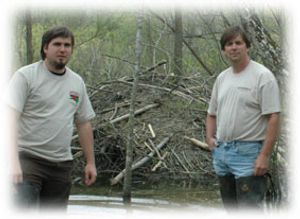
Catawba College’s ecological preserve has a way of capturing students’ attention. It’s where they study the reclusive mole salamander or train their binoculars on the cavity-dwelling prothonotary warbler or watch the erratic flight of the Falcate orangetip butterfly.
;The students’ current fascination is with a pair of beavers that have built a seven-foot-tall lodge on the southern part of Lake Baranski. Two-or three feet of the lodge is submerged, but the beavers’ activity is readily apparent. The trunks of about two dozen trees, ranging in diameter from three-to-12 inches, bear a suspicious sharpened pencil look. Some of the lower trails are submerged under water. And ditches have been cleverly dug to transport logs by nudging them along in the water rather than dragging them over land.
“Students welcome the beaver because they understand that it’s a natural part of the ecosystem,” says Sean Bloom, a senior from Snellville, Ga.
The largest rodents found in North America and Canada, beavers typically weigh 40-to-60 pounds and can reach a length of 41-to-46 inches with their 10-to-16-inch tail. Sometimes called nature’s hydraulic engineer, beavers create wetlands that cleanse the water by retaining sediments and other pollutants.
Beavers have been in and out of the area now for the last 10-20 years, according to Dr. Michael Baranski, professor of biology. The area is more attractive to them now because it includes more water. “Historically before settlement, beaver made a landscape out here that people wouldn’t even recognize today,” he says. “We basically converted all their formerly engineered habitat into bottomland farmlands.”
The beaver activity is one more example of ongoing change on in this 189-acre natural area, which is located at the back door of the college’s Center for the Environment building.
Once agricultural land, much of it is returning to a wetland environment rich with 150 bird species and a host of mammals, amphibians, reptiles, fish and plant species. Deer, gray foxes and coyotes inhabit the ecological preserve as do red-shouldered hawks and Juvenal’s duskywings and chorus frogs.
Dr. Steve Coggin, chair of the Biology Department, has seen significant change in the bird life since he arrived at Catawba in 1985. Digging Lake Baranski and building other water structures have increased the numbers and varieties of water birds. Ducks, geese, grebes and even an occasional osprey now inhabit the preserve.
“The successional changes going from field to forest have caused changes in birds, too,” he says. “We have seen an increase in the number of yellow warblers and yellow-breasted chats. Both these warbler species are found in young forest.”
Baranski traces the changes in plant life over the past few decades. “Where we once had crop fields with corn plants, we went to weed fields for a few years,” he says. “Then as the soils got a little more saturated, we started seeing lots of sedges and other water-loving plants.” Woody plants like swamp roses and alders followed, and now hardwood trees are getting established.
“Higher, drier areas that were open 20 years ago are now so thick with blackberries, honeysuckle and broomsedge that it’s difficult to walk through them,” Baranski says. “In another few years it will all be young saplings.”
Some trees could be affected by the beaver activity. “Some trees can handle periodic inundation,” Baranski says, “but probably none will be able to handle permanent inundation.” In the preserve, species like the black willows and the swamp cottonwoods are able to survive having their roots inundated for a longer period of time than the red maples and green ashes. But trees in this area must have a certain period of dryness to thrive.
The beavers are clearly giving the students another lesson in interconnectedness. “They view this as an opportunity to learn about another species and how it impacts the ecosystem,” Bloom says. “They’re interested in seeing what’s going to come of it.”
